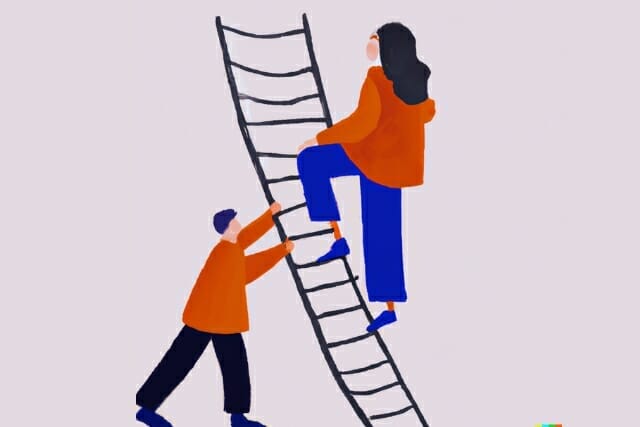Understanding allyship
Allyship is the supportive actions from people who belong to relatively advantaged groups (e.g., men) towards people from less advantaged social groups (e.g., women). To successfully engage in allyship, men first educate themselves about gender bias and the barriers that women (and men) face at work because of their gender. Equipped with this information, they can share this knowledge with others, interrupt negative bias, and intentionally act to support women at work. So similar to mentors, allies provide resources and support to other employees. But, given their deeper understanding about gendered barriers, allies can also interrupt subtle, yet frequent (and harmful) acts that systematically undermine and exclude women and other minorities.
Critically, allyship focuses on advantaged social groups like men because they often have the organizational resources and decision-making power to promote (effective) change. Moreover, it is often men’s commitment and action towards gender equity that legitimizes Diversity, Equity, and Inclusion efforts.
Paving the way for top talents
By challenging outdated stereotypes, interrupting all-too-common microaggressions, and promoting voices of those who often go unheard (e.g., women), allies can pave the way for top talents to rise to the top. When men engage in allyship, they acknowledge that gender bias exists while also recognizing the importance of creating a culture where everyone can succeed based on their skills and contributions–regardless of their gender. For example, if a colleague repeatedly interrupts a female coworker during a meeting, an ally can recognize the behavior and use their privilege to amplify her voice and bring attention to her contribution. Thus, allies create a more inclusive workplace culture that fosters a culture where everyone feels valued and is heard.
Moreover, allies make sure that all employees can access resources and experiences to develop their careers. For example, women often have more “invisible” tasks at work (e.g., organizing events and taking notes in meetings) while also often receiving lower quality feedback and fewer developmental opportunities. In such instances, allies can step in to level the playing field by ensuring women and men receive equitable opportunities to thrive at work.
So, in an age of talent shortages and “pipeline” problems, allies can help organizations to make the most of their trained talents and ensure they can also contribute to team performance.
Allyship as leadership
By engaging in allyship, men also lead the way at work by training the skills needed to navigate the increasingly complex challenges of modern organizations. By supporting women, men practice and build key leadership skills such as perspective taking, active listening, communication, humility, and courage. Indeed, learning about the often invisible gender biases and deep-seeded male privileges, attending to the needs of others, and taking action requires several of these soft skills—but these are also essential effective leadership skills for resilient, sustainable, and high-performing workplaces more generally.
Curious to learn more?
Are you – or someone you know – interested in (male) allyship? We recently developed an allyship training at CCDI (FIM-HSG) to prepare men with the knowledge and skills needed to lead the way as allies in their organizations. As part of the program, men have a space to discuss their allyship challenges as well as the opportunity to connect and network with other men in their allyship journey.
Overall, by embracing allyship, men not only pave the way for top talent but also cultivate essential leadership skills.
About the author(s)


Eugenia Bajet Mestre Programme Manager und Research Assistant
Newsletter
Get the latest articles directly to your inbox.
Share article
More articles
The Future of Work and the Central Role of Diversity & Inclusion
Leadership in Transition: Five Trends of Modern Leadership
The future of work – also relevant for the legal market?
Why inclusive leadership matters for every generation
Do young lawyers need leadership, too? Classification according to generations – slightly arbitrary, but useful

